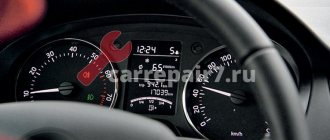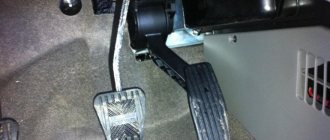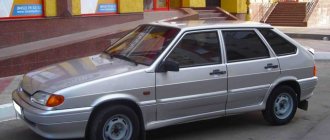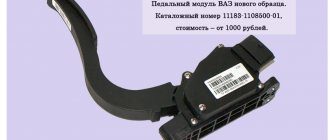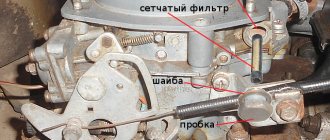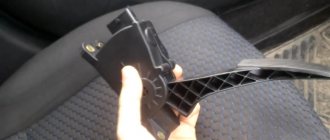Failure when pressing the gas sharply
The gas pedal (electronic) has been installed on VAZ cars since 2011. Up to this point, a conventional (cable) assembly with TPS and IAC sensors was installed.
Advantages and differences
The electronic gas pedal on the VAZ 2114 does have a number of positive aspects, but also some disadvantages, which we will discuss later. First, let's look at the shortcomings of the “cable” that forced engineers to look for new solutions:
- Very frequent over-throttle
of the engine, which led to sharp pressing of the accelerator pedal and the release of a large amount of CO2 into the atmosphere; - Fuel consumption
did not always correspond to the speed limit and speed of the power unit. During the “slippers on the floor” period, fuel was poured into the flammable chambers in excess of the norm; - The need to transition to European environmental standards Euro-4 and Euro-5;
- Over time, increased speeds negatively affected the entire crank and piston mechanisms, which led to increased wear and premature failure, which means that a major overhaul was just around the corner and was breathing in the back.
Now let’s dwell a little on “electron gas” and its advantages
:
- Uniform opening of the throttle valve;
- Preventing gas overloads, which means saving fuel;
- Despite the “dullness” in the first second of pressing the gas pedal, the acceleration dynamics are an order of magnitude better than the analogue;
- Uniform filling of all cylinders with the combustible mixture.
As we see
, at first glance, the advantages are obvious and really significantly improve the technical characteristics of the car. But there is another opinion with some disadvantages, which are discussed a little below. Perhaps the dissatisfaction is expressed by the category that wants to get much more from stock units. Which is practically impossible in theory.
Problems and solutions
There are a lot of reasons for unstable idle, and they apply to both carburetor and injection engines and even diesel engines, both to the old type design and to the new E-gas pedal, which AvtoVAZ is so proud of. Let's start with the problems that occur in carburetor-type engines:
- The fuel-air mixture has become lean. To fix the problem, you just need to make an adjustment to the level of eight hundred revolutions.
- Unstable running can also occur due to wear on the carburetor valve. In this case, the engine operates exclusively with the choke mode extended. To fix the problem, you need to replace the defective part with a new one.
- It also happens that the system channels become dirty. Then the fuel does not receive the required portion of air and leads to failure. Here you just need to clean the channels.
In the injection type of engine, there are no fewer reasons for failure.
- The first thing you can check is air leaks. Be sure to check the connection between the intake manifold and the cylinders to see if the gaskets are worn out. There are rubber plugs on the same manifold; if they are cracked, it is better to replace them. You can check all this by buying carburetor cleaner or any other flammable item in the store, start the car and spray all the joints, if there is a leak, the car will start to twitch, look in that place.
- They can cause gaps in speed and malfunctions in the IAC sensor (idle air control), it is often enough to remove it and clean it or inspect it for damage and replace it if necessary.
- It would not be amiss to check the throttle assembly, since it is not the strong point of the fourteenth model. It is possible that the throttle valve is simply clogged, which causes failures in the entire system. Cleaning it is not at all difficult; this work can be done independently.
- Wear or contamination of spark plugs also affects idle speed, as well as the entire operation of the engine. This is perhaps the most quickly solvable problem that can be eliminated by replacing old spark plugs with new ones in five minutes.
But problems with electronic equipment, in particular the famous E-gas, are much more complicated. Here it is observed:
- regulator failure (IAC);
- DMRV sensor failure;
- failure of the EGR valve (adsorber);
- damage to wires.
The regulator is checked using a multimeter. If the device produces unacceptable values, above 80 Ohms, then you need to replace the regulator with a new one, since repairing it will be problematic.
If the regulator is normal, then you need to check the mass air flow sensor. The check is as follows: the connector is disconnected and the motor is turned on.
If the speed dynamics, at the initial one and a half thousand revolutions, increases, there is no doubt that the breakdown lies in the sensor. As practice shows, 80% of VAZ-2114 malfunctions lie in this part.
Unstable to long-term operation and EGR, which regulates exhaust gas emissions. When it fails, operation can be normalized by cleaning the valve.
And the last thing that should be checked is the condition of the air filters, which on the fourteenth get clogged quite often, and the ignition system itself.
So, we found out the reasons for the occurrence of unstable idle speed of the fourteenth VAZ model and learned methods for eliminating them. All that remains is to wish that your swallow works without failures and pleases you with excellent work!
No duplicates found
The viburnums had an electric pedal.
on the VAZ-2114 there is an electronic pedal.
Perhaps the author should correct it, not “from Granta” but “from 2010-2012”. VAZ 2113, also e-gas
Thanks for the addition, but it’s no longer possible to edit a long post (or I don’t know how).
Thank you for the excellent post, I would like to know how to adapt the pedal through a wire, I just adapted it mechanically, I didn’t feel the difference, VAZ 211340 2012 e-gas car. I have a laptop and a wiring harness (OBD2), I would appreciate any help.
The guy has a 2008 2114 with an electronic pedal.
Ecology is ecology, but the transition to an electronic accelerator pedal was largely due to the fact that the leader in the production of automotive electronics, Bosch, began in the 2000s to switch to a torque model of engine control in its ECUs. Instead of the usual and understandable OZ for fuel and correction, they began to introduce algorithms for optimal control of the ECU.
Regarding the reaction to the accelerator pedal, this problem was present in one way or another on all cars in the first generation of this system. Moreover, most of all they complained about the French. The Germans had this moment better worked out from the very beginning. And since 2005, it’s not possible to feel much of a difference.
As for our cars, the problems with the throttle were caused not by the environment, but by insufficient refinement and tuning. Because after VAZ and UAZ switched to Bosch 17.9.7 and analogues (to avoid a monopoly) in the form of M74, problems began to appear in commercial vehicles, with increased fuel consumption, sometimes with an immobilizer, with deterioration in performance. And in the first 3-4 months, people calmly opened the algorithms, completed them, configured them, and already offered normal solutions for chip tuning. Where no crutches in the form of boosters are needed.
Thank you for the clarification!
Good afternoon. The car is VAZ 211340 2012 e-gas. I will be glad for any help in solving problems to bring it back to normal. What firmware do you recommend, and how to flash it correctly.
I would recommend stock firmware first. Then figure out what doesn’t suit you. By the way, what’s not to like? if it’s a pedal, then you can install a regular throttle and change to firmware without e-gas
Everything is completely stock, nothing was changed, and if they were changed, it was with similar spare parts, there was no talk of tuning. The problem is with the speed, they float not bad. Also, the car may stall when I reverse. This is roughly what it looks like from the outside. I put it in reverse, squeeze the clutch, put it in neutral, slow down, the speed drops and as a result the car stalls. This happens not only in reverse gear. Usually before a traffic light. I slow down, depress the clutch, put it in neutral, slow down (the speed is around 2-7 km per hour, and the revolutions drop to 500, then sharply to 1200, and seem to return to normal. https://www.drive2.ru/b/921974/ there is a very funny letter from Auto Vase.
I quote: “On cars of the Lada Kalina family, equipped with an 8-valve engine, an electronic accelerator pedal and air conditioning, a possible place for the discrepancy to occur is “Speed up by 1500 - 2500 rpm at the time of gear shift to neutral” and “ Increase in engine speed when driving in neutral gear from 500 rpm to 1200 rpm.” To eliminate these inconsistencies, it is necessary to reprogram the ECM controller using the PB-6 programmer produced by NPP New Technological Systems, Samara (additionally, you need to purchase a cable for the M74 controller from NPP NTS, Samara), file I444CE08.hex .
In AGO, use defect code 1411020 000 008 “Reprogramming the controller with software I444CE06”, culprit 00001, labor intensity item 87088 – 0.3 n/hour. In the descriptive part of the AGO (field “Description of the defect”) and RA (in the column “Special notes on the complaint”), it is necessary to indicate the manifestation of non-compliance on the vehicle.”
That is, they openly say that everything is fine, don’t worry, just buy it and reflash it yourself. There are no problems with buying, but with reflashing, as if for the first time, I’m afraid to mess up. Maybe you can help me solve my problem.
Disadvantages of the electronic pedal
- A slight “thought” at first when pressing the accelerator;
- The “E-pedal” does not make it possible to carry out deep tuning, since for this it is necessary to convert to a “cable” system, and this is an additional expenditure of about 20-25 thousand rubles plus a bunch of sensors and cables. Not everyone will agree to such a hassle;
- Exclusively on the first (raw) versions with “e-gas” the pedals stuck, the engine speed fluctuated and random periodic self-pressing occurred;
- Most likely the second point is to blame, which does not allow you to upgrade the car.
But what to do if an avid driver wants to drive recklessly?! Our craftsmen found the optimal solution without removing the “e-gas” - this is re-flashing the sensors and adjusting the turbochargers.
How to remove the idle speed sensor
Replacing the idle air control valve on a VAZ is very simple
To remove the sensor, you need to put the car on the handbrake and disconnect the negative terminal from the battery. Next, you need to disconnect the wiring harness from the sensor and clean the place where the IAC connects to the throttle pipe body - so that dirt and sand do not get into the mounting hole. The sensor is secured with two screws, which must be unscrewed with a screwdriver or ratchet.
Design and principle of operation of “e-gas”
By default, an electronic pedal consists of: an electronic damper, the pedal itself, and a chip sensor on the pedal itself. The operating scheme is as follows: when you press the accelerator, the electronic sensor amplifies the signal and transmits it to the electronic control unit (ECU), which indicates to the damper the degree of opening or closing.
But sometimes these transitions can't always keep up with the software. In this regard, sensors often produce “correlation violation” errors. There are two ways to cure the problem of “dampness” in the system:
A complete replacement of the chip board with a re-flashed (unlocked) one with the ability to set modes “for yourself” and regulate emissions into the atmosphere yourself. As a rule, in such situations, drivers return to Euro-2 standards
and increase engine power by 15-20% plus;
The electronic gas pedal on the VAZ 2114 is replaced with a similar new one, but the chip remains the same - not hacked, which means it will not break again for the first time.
The electronic gas pedal has been installed on VAZ cars since 2011. Up to this point, a conventional cable gas pedal assembly with TPS and IAC sensors was installed.
How to replace IAC on a 1.6-liter injection engine
A feature of the maintenance of the 1.6-liter injection power unit installed under the hood of the VAZ 2114 is the somewhat difficult process of replacing the IAC.
Video about the reasons for the incorrect operation of the IAC
If on a one and a half liter engine everything is done literally in one breath - in accordance with the instructions above - then a more powerful engine requires more attention.
Replacement procedure:
- Remove the engine protective cover;
- Loosen the clamp securing the air filter pipe and disconnect the corrugation itself;
- Next, you need to unhook the throttle cable;
- By unscrewing two nuts 13, the entire throttle assembly is removed;
- To avoid getting into the engine once again, you can clean the throttle valve with carburetor cleaner;
- The wires are disconnected from the sensor, 2 screws are unscrewed;
- Installation of a new sensor and assembly are carried out in the reverse order.
Disadvantages of e-gas
- A slight dullness at start - the engine's responsiveness to the gas pedal becomes slower by about half a second. (Treated by installing a spur).
- Lack of deep tuning capabilities. To get serious about tuning your car, you will have to get rid of the e-gas and switch to a regular cable. (The cost of alterations is approximately 20 thousand rubles: brains, sensors, wiring, pedal). True, they are now slowly learning to flash e-gas, configure turbo engines and compressors. The future is naturally in e-gas.
- The first models with e-gas often have problems.
Problems associated with e-gas
As mentioned above, the first models with e-gas encountered common problems:
- revolutions float;
- pedal sticks;
- The car presses on the gas itself.
Important! AvtoVAZ has issued an information letter that talks about the need to adapt the electronic gas pedal after replacing the controller or removing the battery: How to adapt e-gas?
Buy a new regulator or try to clean the old one - which is better?
If you are sure that the idle speed sensor is not working, you can try cleaning it. To do this, it is better to use WD-40 or carburetor cleaner. After disconnecting the wires from the sensor, simply clean the connector contacts using a cotton swab moistened with cleaner. It is also important to rinse the locking needle with an aerosol stream. This often helps, and the engine stops running at idle, and the car behaves normally at intersections and when braking for some more time.
How does e-gas work?
E-gas consists of 3 elements: Electronic damper, sensor on the pedal, and the pedal itself.
The sensor on the pedal takes into account the degree to which the driver presses the gas and transmits the data to the ECU. The computer, in turn, sends a signal to the electric damper, which opens the way for air to enter the engine. Also in cars with an electronic pedal, frequency-type air flow sensors are used.
Each sensor is powered separately to the computer. In case of the slightest voltage deviation from the norm, errors appear: (P2122-P2123, P2127-P2128, P2138).
Idle speed regulator (sensor) VAZ 2114
At its core, the idle speed sensor is a valve equipped with a shut-off needle, through which the amount of air supplied to the combustion chambers bypasses the throttle valve is dosed. That is, when the damper is completely closed, and the controller comes to the conclusion that it is necessary to increase the idle speed, the idle speed controller (IAC) slightly opens or completely opens the intake port and thereby leans the fuel mixture. As a result, the car does not stall at idle even when driving on a cold engine. A stepper motor integrated into the regulator is responsible for driving the valve needle.
How much does it cost to repair an IAC at home?
Cleaning the idle speed sensor will help bring it back to life.
Despite the fact that the instruction manual for the “fourteenth” Lada does not recommend looking for an alternative to replacing the IAC, many people practice repairing the sensor with their own hands. To carry out restoration work, you need:
- remove the sensor, clean its body and pull out the 3 fixing pins (rivets);
- after this, you can carefully remove the case - so as not to disturb the solder spots of the wires;
- very often the cause of failure is a broken contact - in this case, you need to solder the wiring in place and cover the soldering area with varnish (to prevent corrosion);
- Another problem may be air leakage through the idle air sensor - to solve the problem, you can use a regular sealant, which will eliminate the gaps in the IAC housing;
- If it turns out that the needle guide drive or the guide itself is worn out, repairs will not be possible.
All repair options will require purely symbolic investments, as well as a minimum of time and experience of the performer.
Adjustment
The adjustment process may vary on different car models, since different manufacturers use mechanisms of different designs. But the same principle can be applied for configuration. As for a specific model, it is better to find information on it in advance.
To begin the adjustment, the first step is to remove the pedal from the holding bracket. Next, loosen the screws securing the cover. One screw holds the cover in a certain position - it must be completely unscrewed. The cover is turned to the side clockwise until the end, then the screws are tightened again.
This is interesting: How to make a foam generator for a car wash with your own hands
This adjustment will reduce pedal response time. Some car owners note that after such adjustments, the response speed can even be compared with a mechanical pedal. Adjustment allows you to improve engine performance and improve the start of movement from a standstill.
In cases where a pedal with low sensitivity is needed, it is necessary to rotate the cover in the opposite direction - counterclockwise. The machine begins to respond to presses not so quickly.
Sometimes you can come across harmful adjustment tips - drivers advise placing shims under the lever. This is the wrong approach. Sometimes the pads get caught under the contact pads in the potentiometer, and the machine may lose control as a result.


